The US government is working on regulations to reduce oil industry methane emissions by more than 40% over the next 10 years.
Meanwhile, it is making a large investment in research seeking reliable ways to measure how much of the methane in the atmosphere is from natural gas production versus other sources of the gas that can lead to global warming and smog.
“We can tell how dirty the air is. What is really tricky is ‘where it is coming from.’ ” said Susan Stuver, a senior research scientist at the Texas A&M Institute of Renewable Natural Resources, who was among the first persons to begin gathering emissions data in unconventional gas plays.
There are a growing number of estimates published and they vary wildly, with studies estimating natural gas losses ranging from 1% to 7% of US production, according to a summary in a US Department of Energy research grant.
The methods, the math, and the politics of methane measurement are complex and changing. What once was an economic question facing the natural gas business—how to cut losses of a valuable product—has become a contentious environmental issue of how to reduce emissions of a gas that is able to warm the Earth far more than carbon dioxide?
The US Environmental Protection Agency (EPA) reports that nearly 29% of all methane emissions in 2012 came from oil and gas industry activity. It is the largest source, followed by enteric fermentation, at 25%, which is the digestive process used by grazing animals, such as cattle, producing methane as a gassy byproduct. Those animals also produce manure, which is responsible for an added 9% of methane emitted.
Other estimates suggest far higher industry emission levels. That matters to the oil and gas business because those numbers will guide future emissions rule making.
The public furor several years ago over whether fracturing polluted water supplies led to studies of how unconventional exploration and production (E&P) affects air quality. Some high-profile academic studies said methane leaking from gas operations are far higher than thought, challenging industry claims that natural gas is the cheaper, cleaner fuel option.
“There is a great deal of debate about that. Some academics say it is quite a bit larger than what the EPA estimate suggests and some in industry say it is smaller,” said Mark Brownstein, associate vice president and chief counsel for Environmental Defense Fund (EDF), which has played a unique role in working with industry to lower emissions. The environmental group’s efforts have included backing studies measuring methane emissions at each step in the natural gas supply chain and what can be done about it. It has developed cooperative relationships with E&P companies that provided researchers with access to wellsites.
The combination of industry initiatives and regulation at the state and local level may well alter the emissions outlook. The EPA estimates that the industry’s natural gas emissions are down by 16% since 1990. The largest gains over that period were from reduced emissions from control devices and installation of plunger lift systems. In recent years, some of the biggest gains have come from green well-completion methods, which capture gas that once escaped from fluids flowing back after fracturing. This is either flared or captured, processed, and sold to pipelines.
“Those emissions were dropping dramatically as those control methods were being put in places,” said Dave Allen, a chemical engineering professor at the University of Texas at Austin, who recently completed a study of emissions by well equipment.
Using direct measures of emissions from devices on 377 wells operated by 10 companies cooperating on the survey, Allen gathered data that reshaped the EPA’s pie chart of E&P emissions of methane. The study concluded that emissions during flowback have sharply dropped from 26% in the EPA’s Greenhouse Gas Inventory to 1%. That decline, plus larger-than-expected emissions by gas-powered pneumatic control devices, pushed its share of the natural gas emissions from the EPA estimate of 26% to 42%, making it the largest single category.
The EPA predicted that without further action by the industry and regulators, natural gas emissions would rise by 25% by 2025 as gas production rises. While the federal government is considering further action, some states have made moves. Colorado has become a proving ground for methane emission reduction methods, as well as research seeking better emission measurements.
What began as a deal to sharply reduce methane emissions negotiated among Colorado officials, three oil companies (Anadarko, Noble Energy, and Encana), and the EDF has led to a program to sharply reduce releases of methane and hydrocarbons that are ingredients in smog, known as volatile organic compounds (VOC).
Colorado is also home to a cluster of institutions studying the effect of energy production on the atmosphere. A major effort is under way in Colorado to monitor emissions in a major oil basin and develop a standard for measuring how much methane is emitted and where it was produced.
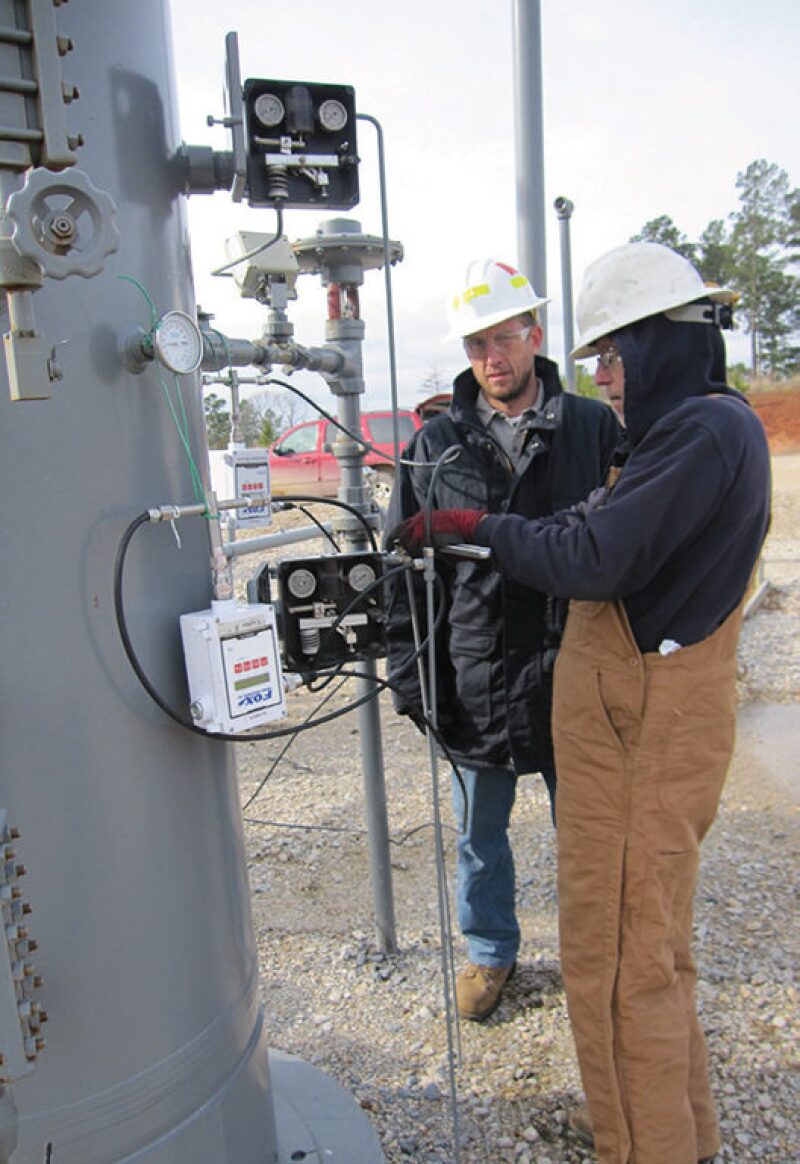
Better methods are needed because recent work has offered contradictory views on methane levels in the atmosphere. A 2014 review of past methane emission studies found a 50% average gap between studies based largely on atmospheric studies of methane, known as top-down studies, and ground level measures of equipment and wellsite emissions, known as bottom-up estimates, according to a study by Adam Brandt. He is an assistant professor in the energy resources engineering department at Stanford University and the lead author of a paper published on this topic in Science (14 February 2014).
The higher estimates are at odds with the numbers found in the EPA Greenhouse Gas Inventory, a widely used performance standard for estimating emissions.
Creating an emissions tracking system that accurately accounts for all the major sources of methane is a huge challenge on many fronts, from the high-cost logistics associated with gathering big data in the air and on the ground to analyzing it using advanced methods needed to simulate how emissions move in the atmosphere.
“None of these things are straightforward,” said Dag Nummedal, director of the Colorado Energy Research Institute at the Colorado School of Mines, who is involved in the monitoring project. “It is complex analysis. It is not like reading a rain gauge.”
Stuver of Texas A&M described the math required for atmospheric emission studies, which is similar to techniques used for seismic processing, as “absolutely eye-melting.”
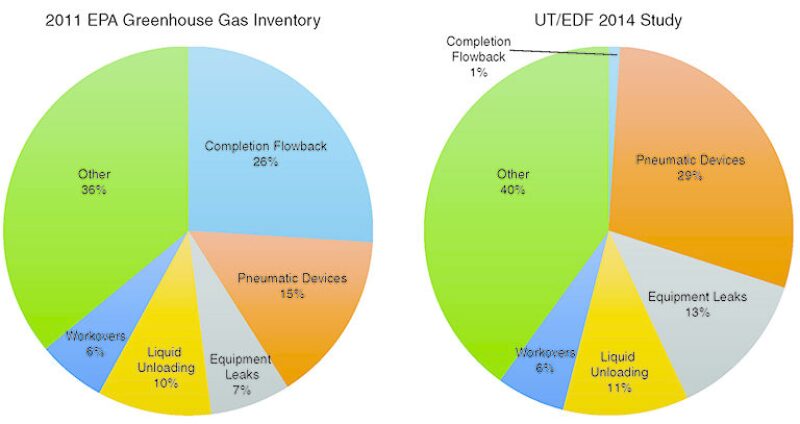
The Fat Tail
A study commissioned by EDF, done by the consulting firm ICF International, concluded that the added cost of a 40% reduction in emissions from the natural gas production, processing, and delivery system would cost about a penny per Mcf and could largely be done using available technology.
“On the whole, this is relatively straightforward to do,” Brownstein said. “This is not rocket science; it is auto mechanics.”
But studies measuring natural gas emitted by well control devices, which are commonly designed to “bleed” small amounts of gas but emit far more when malfunctioning, consistently find that a small group of devices is responsible for a large share of the leaks.
The most recent researcher to make that point was Allen, whose team measured natural gas emissions from 377 natural-gas-powered pneumatic controllers on shale wells operated by 10 participating companies. It found that on average, the gas coming from those control devices averaged 5.5 ft3/hr, or 17% higher than the EPA estimate.
In a previous study, he reported an emissions level that was nearly double the EPA estimate. The difference was the later study measured all devices, including rarely activated ones such as emergency shutdown valves that generally produced no emissions during testing.
The highest emissions came from a relatively small number of devices—20% of those wells produced 96% of the methane emissions. A similar disparity was found in wells where they measured emissions from plunger lift systems, which are used when fluid buildup in low-pressure wells periodically blocks gas flow, leading to storage-tank gas venting.
This distribution is a regular feature in past methane emissions studies. In the supporting documents accompanying the research review in the Science article, a summary of 10 past studies dating back to 1997 found that all large leaks were from a small number of devices.
Comments on the studies included
- Top single leak accounted for 40% of leakage.
- Repairs to 10 largest emitting … components at each site would reduce natural gas losses by 58%.
- Repeated evidence of skewed emissions distributions. Evidence includes top emitters of size 100 times to 10,000 times larger than small emitters.
The Allen report said “many of the devices in the high-emitting group” were not performing as designed. For example, some designed to bleed gas only when shifting a valve were continuously emitting gas. Experts in the participating companies said that was likely due to fixable problems, such as a cracked diaphragm or a device that has been fouled.
Among statisticians, this sort of distribution is called a heavy tail or a fat-tail chart because the sides of the bell curve, which normally drop to near zero, are wider than normal due to the many low-odds events adding to the total emissions.
“The heavy-tailed distribution of observed emissions rates presents an opportunity for large mitigation benefits, if scientists and engineers can develop reliable (possibly remote) methods to rapidly identify and fix the small fraction of high-emitting sources,” Brandt wrote in his Science article.

Profit Motivation
Colorado is trying to reduce the number of high emitters by requiring operators to regularly visit gas-producing wells to seek out and repair or replace malfunctioning equipment.
Results of the Allen study suggest that the program may be working. The Rocky Mountain region, which includes Colorado and Wyoming, had far lower emission levels than the Gulf Coast region, which includes Texas and other states without the requirement. Emissions from controllers, based on the average emission rate and the number of controllers per region, was 10.6 ft3/hr in the Gulf Coast region compared with 0.67 ft3/hr in the Rockies.
Those numbers are based on 30 devices in the Gulf Coast and 25 in the Rockies. The size of the sample is tiny in a universe approaching 500,000 devices. But if the sort of regular monitoring and repair required in Colorado works on a large scale, the reductions could be significant.
Montana has followed the lead of Colorado on required inspections and other states are considering doing so. The EPA’s planned regulations will cover only new sources. For the rest, it is depending on voluntary industry initiatives. That means “90% of the potential emission reduction is from existing sources that is not currently touched by the regulations the administration is going to propose,” Brownstein said.
He questions whether a voluntary effort is enough to spur an industrywide change. “For many in the business, higher returns are associated with developing new wells. And going back to an older site, even if it is losing product, is not a high financial priority,” he said. “Our experience is we can identify individual companies who can, on any given issue, establish a leadership position. But the vast majority of industry will sit back and do only what is required of it.”
Industry groups have responded that the rapid spread of green completions is an indication of what industry initiatives can accomplish. The effort was supported by federal research spending and a federal regulation taking effect this year is requiring the green completions be done generally, where practical.
The methane reduction programs most likely to work are the ones in which the natural gas captured covers the cost of the change, which has long been the most powerful motivation to reduce gas leaks. An example of that is the changing marketing program for EcoVapor Recovery Systems, a young company selling a new system to capture and process natural gas in oil storage tanks that otherwise might be vented or burned.
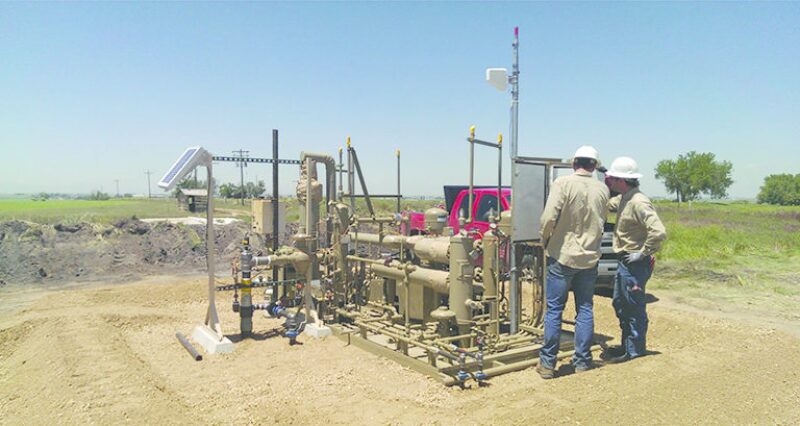
“When we stared in 2010, we thought the main value proposition was emission control,” said Mark Gorham, chief executive officer of EcoVapor. At the time, the EPA was working on programs to reduce methane and VOCs. He said that “initially the pitch was we can control 100% of emissions. Also lower tank pressure means less ventilation from tanks,” reducing the safety risks for workers.
Colorado’s tough emissions standards got potential customers thinking about vapor capture, and that has now become the company’s main market. It has established a foothold with a large independent operator in Oklahoma, where operators had more options to reduce emissions under a federal rule to reduce VOCs, known as Quad O. “They realized how valuable the gas stream was and said ‘wow, we could make money here,” said Gorham, who plans to expand next into Texas. He said the economics of capturing gas flashing out of oil in tanks depends on the volume of gas coming out and what percentage of it is in the form of liquids, which are more valuable.
Profitably finding and fixing leaks in pneumatic control devices presents a cost challenge when gas prices are low. While the potential volume of gas gained from finding and fixing high-emitting devices is large, the savings per device repaired or replaced may not be. For example, in the UT-EDF study, a high-emission device is considered one that emits an average of 6 ft3/hr or more. At this threshold rate, it would take nearly 7 days of constant emissions to reach 1 Mcf, which was recently worth less than USD 3.
For that reason, the cost of leak detection has become a priority for the Advanced Research Projects Agency–Energy (ARPA-E). The US Department of Energy agency, which invests in new energy technology, recently announced USD 30 million in grants to support 11 projects developing methane-detection devices that are smaller, more energy-efficient, deliver more data, and cost significantly less than what is now available.
“We know how to measure methane. But it is expensive so it is done infrequently,” said Bryan Willson, a program director at ARPA–E. As a result, “we do not have the data we need to feed back into operations.”
The list price was just one of the agency’s cost measures. Another significant expense limiting the number of inspections is the time needed to visit scattered well locations, often in remote places. Even when a crew goes out, it may miss a problem that occurs only sporadically. That argues for continuous monitoring by battery-powered devices capable of recognizing a significant increase in emissions and notifying a central control center. ARPA-E is supporting work on such a device and EDF is seeking ideas on how to create a device that is the equivalent of a smoke alarm.
Conflicting Estimates on Methane Emissions Spawn More Work To Narrow the Divide
“Where we are heading with these instruments is putting on wireless sensors and sending those readings to a nerve center telling the operator this is leaking,” Stuver said.
Methane is a potent greenhouse gas and the prime component in natural gas. Those two facts have focused people’s attention on how much natural gas escapes into the atmosphere, leading to a spate of studies generating debate, confusion, and more studies.
The big problem has been the wide divide between the emission estimates based on ground measurements, known as bottom-up, and the higher levels observed from airborne measures, known as top-down.
Faced with these contradictory reports, the federal government has paid for more studies, hoping for reliable regional estimates of the methane in the atmosphere and its source, and also a standard measurement methodology.
“As shale development has increased over the years, there have been a couple of environmental topics that have snuck up on it. One is induced seismicity and methane emissions is another one,” said Kent Perry, vice president of onshore programs at the Research Partnership to Secure Energy for America (RPSEA), which is supporting methane measurement research. Its goal is “as much as anything about the quality of the emissions data.”
In Colorado, RPSEA is backing a USD 4.2 million study that will attempt to develop a standard procedure for simultaneously measuring methane levels in the air and seeking out the sources on the ground. The emissions reports from the Denver-Julesberg Basin will be closely followed in a state where there has been a loud debate over oil and gas development. The grant summary, though, said the top priority is developing an accepted method for melding ground and air data to accurately measure the sources of methane emissions.
“The biggest issue really is to narrow down the uncertainty currently, and reconcile the top-down and the bottom-up” study results, said Dag Nummedal, director of the Colorado Energy Research Institute at the Colorado School of Mines. The university is a key player along with the National Oceanic and Atmospheric Administration, the National Renewable Energy Laboratory, six other research partner institutions/companies, and four natural gas companies.
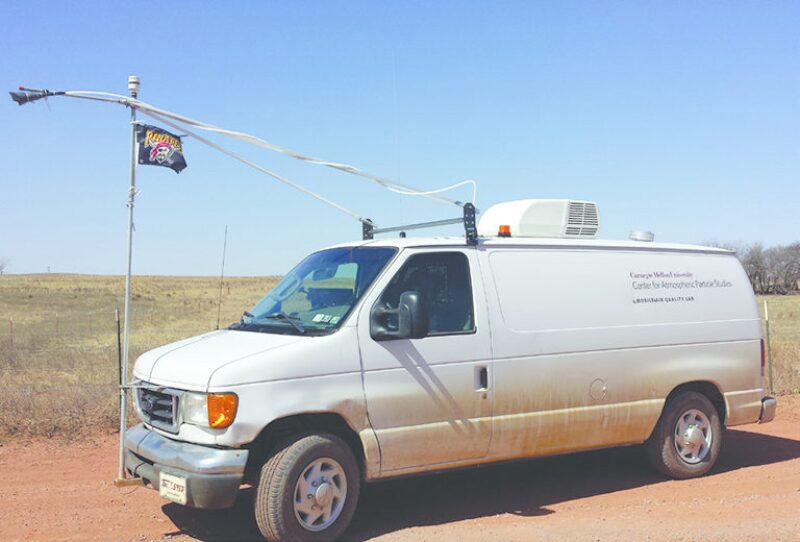
The scale of the team is in line with the magnitude of the task, which is as big as the sky. Natural gas producers are on a long list of potential emitters, including cows, coal mines, landfills, ponds, natural seeps, and even termites. Researchers are faced with sorting out the source of all that methane after it has been moved and mixed by the wind and the sun in hard-to-predict ways.
There are three federally backed projects at an early stage. In Colorado and Pennsylvania, the studies are aimed at combining a wide range of data to create estimates of emissions of methane and related hydrocarbons that are ingredients in smog. The Colorado study will rely on airplanes to gather atmospheric data over an oil and gas producing basin, while the Pennsylvania one will place sensors on towers to measure emissions from gas production. A third study in Utah is looking at a variety of methane sources where little data has been gathered in the past.
A look at the Colorado project shows there is nothing easy or cheap about trying to bring together the top-down and bottom-up climate measures.
“The logistics of this are difficult,” Nummedal said, adding, “There are a number of challenges: the weather, the equipment availability for overflights, the time commitments from operators to share information at any given time, and the money to pay for operations and teams.”
Since the grant money began coming in back in August, the team has been gathering ground emission data and working on organizing the air and ground data gathering effort.
The first overflight scheduled for the Colorado program came at a time “when there was early cold weather with intense windstorms,” Nummedal said, adding that the experience provided data and a better understanding of the logistics of managing a large team as conditions change.
Getting Enough
In Pennsylvania, a project backed by the US Department of Energy’s National Energy Technology Laboratory (NETL) will look at methane emissions in the Marcellus Shale. What makes it unique is that it will be the first study to use communications towers to monitor methane emissions in a large gas-producing area, said Kenneth Davis, a professor of meteorology at Penn State University, who is leading the project.
The towers will be used to measure emissions over a 2-year span, using instruments able to distinguish different types of methane, based on isotope identification that can tell whether the gas came from deep in the Earth or from a biological source.
The tall observation points will be on the northern, southern, and western edges of the study area in northeastern Pennsylvania plus two within it. The design, based on prevailing wind directions, will allow them to measure how the chemical makeup of the atmosphere changes from stations upwind to observation towers in the zone.
Airplanes will also be used to ensure the data gathered by the fixed sources represent a bigger picture. “It can be hard to tell if it is seeing a relatively weak source under the tower or a really strong source further away,” Davis said.
So far, the focus has been on gathering data on ground-level air quality, as well as the many sources of methane. Those sources include information on the likely emission from gas industry facilities, livestock operations, landfills, wetlands, and water-treatment facilities. In that part of the state, coal mining, which can emit large amounts of coal seam gas, is not a factor.
Davis’ team is negotiating leases to put sensors on towers and gathering surface data that will define the design of the tower network. Vehicles equipped with air-testing equipment are traveling the roads to measure the typical chemical content in the air in that rural part of Pennsylvania.
Another team was traveling to wells to measure emissions downwind from wellsites. That work is being done by Albert Presto, an assistant research professor at Carnegie Mellon University, who has a NETL grant to do air studies at wellsites in Pennsylvania. He is using a specially equipped van with a long tube like an elephant’s snout extending over the front to sample the air.
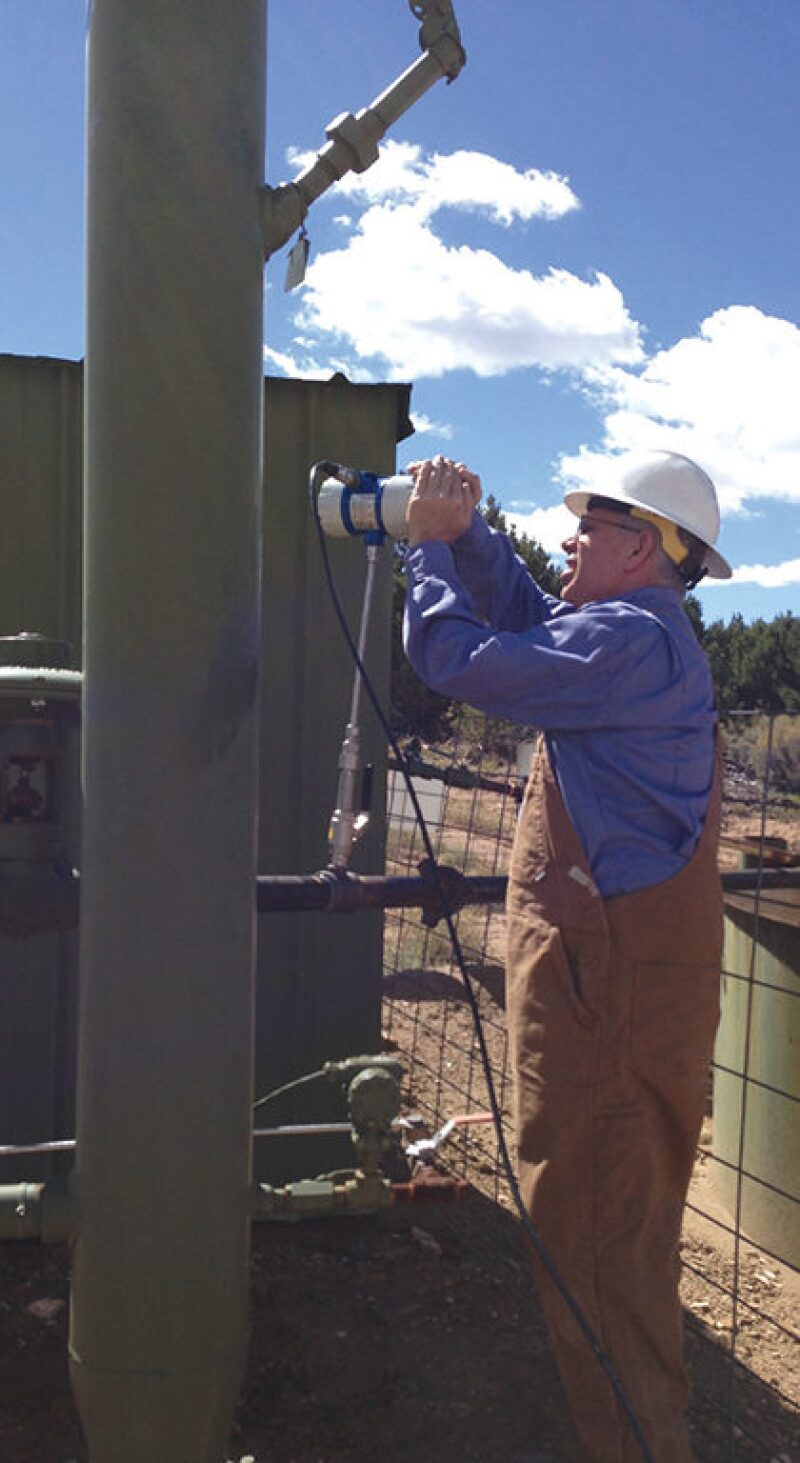
To ensure he is downwind, Presto releases a set amount of tracer chemicals upwind. When he begins sampling downwind, the tracers are used to confirm the path of the emissions and estimate how the gas concentration has changed as it moved away from the well.
“We cannot work if the wind is not cooperating,” Presto said. A breeze is needed to push the fumes from a wellsite, but too much wind can interfere with measurements.
For Davis, changes in the wind direction are a positive factor because they offer a larger sample of the surrounding country. But accurate weather modeling is needed to interpret local data, because there is no way to wall off the test zone.
“The history of greenhouse gas monitoring is global, like what has been done at the Mauna Loa observation station, which has been measuring since the 1950s,” Davis said. “On a regional level, there is quite a lot of uncertainty.”
Those observations will be combined with ground-level emissions data on what is producing methane. Melding all those sources of information is as big a challenge as gathering the data.
“The benefit of the regional approach is that we measure all the sources. The disadvantage is that we measure all the sources,” Davis said.
Other Sources
Gas from natural seeps is a problem facing Davis. While seeps have been widely observed in Pennsylvania, he has not found a source that offers a generally accepted measure of them. “We will take a stab at natural seepage from geological formations,” he said. “It was originally not on our radar, but people in the gas industry said it is a significant factor.”
Gaps are common in the methane emissions database. RPSEA is supporting a study in Utah to measure potential methane sources that have gotten little attention in the past, and develop methods to gather such information. “We focus on looking at sources that have been neglected in the past, where we do not have good number right now,” said Seth Lyman, a senior research scientist at Utah State University leading the project.
He has begun a yearlong study of emissions of methane and volatile organic compounds—methane and other hydrocarbons that are ingredients of smog—from ponds filled with produced water to see if natural gas vapors in the water are contributing to global warming or smog over the Uintah Basin in Utah. It should be a good area to look at how E&P emissions affect the atmosphere because it is a rural area where oil and gas wells are among the only industrial sources of gas.
The study is a labor-intensive effort requiring multiple visits to five facilities using a dome-shaped collector to trap vapors rising out of the oil or from ponds filled with produced water. The gas observed may be the product of natural gas left after separation or the product of bacteria breaking down remaining oil or additives. Lyman is also studying if the soil on well pads and elsewhere is emitting methane. While he expects that contribution from the sources may end up being a small slice on a methane emissions pie chart, the top-down emissions studies suggest that more work is needed on the ground to measure sources that have been missed or undercounted.
“I would not be surprised if ground-level emissions estimates are low based on the atmospheric testing,” he said.
The Search for Cheaper, Better Gas Monitoring
Growing pressure to find and reduce methane emissions has made selling devices capable of detecting the elusive gas a growth business.
Keeping up with all the new offerings has been a challenge for Susan Stuver, a senior research scientist at the Texas A&M Institute of Renewable Natural Resources, whose work on monitoring oilfield methane emissions includes looking for better, more affordable tools.
“I have a student working on nothing but researching methane sensors,” she said. Nothing has checked all the boxes on her wish list. For detailed, accurate measures, Stuver and other researchers rely on instruments from companies such as Picarro and Kassay Field Services. The devices plus the required accessories cost more than USD 100,000, which is a lot for someone whose work is supported by environmental research grants.
Some devices fail to offer the readings required. Others look affordable, but samples must be sent off for costly laboratory analyses. And there are those that fail to perform in the field. “You never know until you test it. A lot of new startups do not have the resources to do a legitimate third-party verification,” said Stuver, who invites those with new offerings to measure their performance against her mobile lab.
Shortcomings in what is available now have also been noticed by the US Department of Energy’s Advanced Research Projects Agency–Energy (ARPA–E). The agency recently announced USD 30 million worth of projects with 11 companies and research institutions to develop a new generation of devices to detect methane and volatile organic compounds (VOC), which are components in smog.
The goal is to eliminate a barrier limiting efforts to find and fix natural gas leaks, which is the high cost of the hardware needed to dependably spot problems. In this case, the cost is a function of the device’s list price, the value of the information it provides, the ability to operate in field conditions, and operate autonomously.
The grants are split between devices using optical or chemical sensors to detect, measure, and report natural gas emissions, and another five grants are for creating things that will improve the performance of future devices.
Bryan Willson, program director of advanced research projects at ARPA-E, highlighted the program’s priorities by describing three of the grants:
- Better components. Maxion Technologies is working on producing an affordable, laser light source that sends out light at a wavelength (3.3 μm) that is far more effective for imaging methane gas than the ones commonly used (1.6 μm), which were designed for the communications industry. The challenge is to lower the high cost of making a better laser for a small group of users.
- Cheaper, smaller, and quantitative. Bridger Photonics is working on using light detection and ranging (LIDAR) to rapidly create 3D images to identify the location and size of methane concentrations at a lower cost than what is on the market.
- Constant surveillance. Palo Alto Research Center (PARC) is working on a chemical detector on a chip using a nanomaterial whose electrical resistance changes when exposed to hydrocarbons. Its goal is to create a tiny sensor on a chip that can be cheaply produced with printing methods used for making microchips.
The PARC project is aimed at satisfying the need for a “very low-cost, low-power chemical sensor that can be sprinkled around a site and talk to a base station,” Willson said. The goal is detection using a “device that is always there that allows you to detect more quickly so you do not have to wait until the next site visit.”
The project uses material developed by NASA to seek organic compounds in remote places where space and electrical power are scarce. “The basic idea is to make a very cheap device, using chemical sensors made from nanomaterials,” said David Eric Schwartz, manager of Energy Devices and Systems at PARC. The key element in the device is carbon nanotubes modified to measure specific gas properties. Specific chemicals change the resistivity of the nanomaterial.
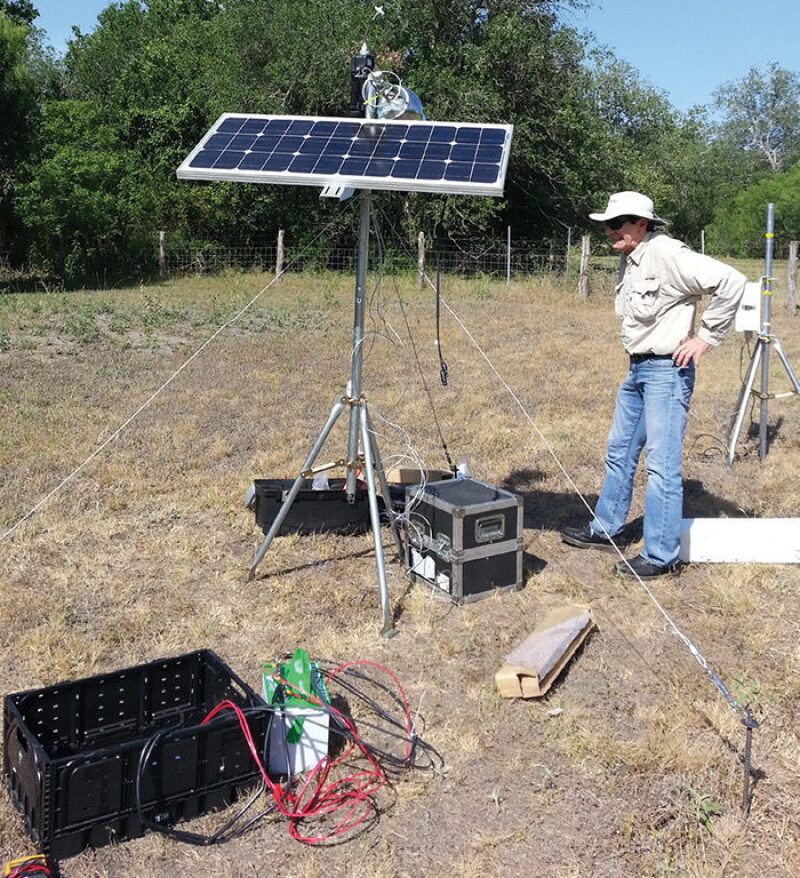
The unit would be built around a microcircuit with a tiny amount of the nanomaterial printed on plastic that is flanked by two electrodes sending an electric current through it. When exposed to a target gas—in this case, methane, but it can be adapted for others—the resistance changes the current in a measurable way. Data from a group of these circuits—with nanotubes tailored to measure different things—would form a tiny sensor.
“It is an electronic nose. It works in a similar way to a nose with multiple receptors,” Schwartz said. By printing multiple sensors on a single sheet of plastic, “we could mass produce them so they could be put on different gas wells and send a signal back to the control center,” he said.

Schwartz said they want to create a battery-powered unit that can be placed on a well. The target price per sensor is USD 10, with a system requiring multiple sensors and related equipment adding to the total, he said. As with most of the ARPA–E projects, the plan is to create a device that is ready for testing in 3 years. The agency has the job of setting up a realistic test method.
While PARC is working on a nose, most methane measurement methods depend on the eyes, using infrared imaging to show the presence of an otherwise colorless gas.
In the optical group is Rebellion Photonics, which is on the ARPA–E grant list. While its gas imaging and measurement device was originally designed for monitoring large processing facilities, such as a refinery, the company’s biggest business now is using the device to look for oil tanks that are venting gas in Colorado oil fields, said Allison Lami Sawyer, chief executive officer for the Houston company.
Willson said the ARPA–E grant is aimed at modifying “a site-mounted sensor that is large and expensive” by significantly reducing its cost, size, and energy consumption, so it is an affordable option for deployment at a well, or even on a worker’s hard hat.
The Rebellion Gas Cloud Imaging camera is used to image and measure a variety of chemical emissions from a distance. Sawyer said that ability speeds inspections by allowing the device to cover a wide area without requiring a visiting inspector to climb up on a storage tank. The device is programmed to measure how much methane has been released, and its data are downloaded to a cloud-based database that can be viewed by those who decide whether to send someone out to check it.
“A video also can motivate them to go out,” said Sawyer. There is “something about when they see it on a screen; it is more convincing.”
For Further Reading
Methane Emissions from Process Equipment at Natural Gas Production Sites in the United States, by Dave Allen et al., Environmental Science & Technology, (49) 1, 2015, pp 641–648.
Methane Leaks from North American Natural Gas Systems, by Adam Brandt et al., Science, 14 February 2014.
Oil and Natural Gas Sector Pneumatic Devices, US EPA Office of Air Quality Planning and Standards, April 2014.


